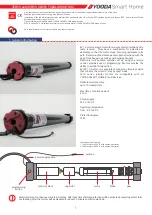
12
TESTING
1. After repeated efforts to start the engine using the procedure listed in the operators manual fail, check
for spark by removing the high tension lead and removing the spark plug. Install a commercially available
spark tester and check for spark. If the spark is bright blue and consistent, proceed to step 2. If no or
irregular spark see Chapter 8 under "Testing".
2. Visually inspect the removed spark plug for a wet condition indicating the presence of gasoline in the
APPROVED CONTAINER OUTDOORS, AND AWAY FROM ANY OPEN FLAME OR COMBUSTION
SOURCE. BE SURE THE ENGINE IS COOL.
NOTE:
Todays fuels can cause many problems in an engines performance, due to the fuels quality
and short shelf life. Always check fuel as a primary cause of engine performance.
4. Remove the air filter, heater box, or air cleaner assembly if applicable to visually check that the choke
shutter completely closes or check to see if fuel comes out of the main nozzle during priming.
5. If the fuel flow from the tank is adequate and no fuel is evident during priming, the carburetor will need
to be removed for service. See Service in this chapter or consult the Carburetion Troubleshooting
chart to diagnose carburetor symptoms. Improper fuel flow indicates the fuel, fuel line, filter or tank
require cleaning or replacement.
6. Check the engine compression using a commercially available compression tester and follow the
testers recommended procedure. Low compression, a dry spark plug, adequate fuel flow, and a known
good functional carburetor indicates an internal engine problem exists. See Chapter 9 under
Troubleshooting.
7. A wet spark plug indicates fuel is being supplied by the carburetor. The engine may be flooded by
a restricted air filter, carbon shorted or defective spark plug, excessive choking or over priming,
improperly adjusted or defective carburetor. With the spark plug removed and a shop towel over
the spark plug hole, turn the engine over slowly 3 or 4 times to remove excess gasoline from the
engine cylinder.
CAUTION: KEEP ALL COMBUSTIVE SOURCES AWAY. AVOID THE SPRAY FROM THE SPARK
PLUG HOLE WHEN CRANKING THE ENGINE OVER.
8. Replace the air filter if restricted or oil soaked. Replace the spark plug if questionable. Install the spark
plug and high tension lead and try to start the engine.
9. If the engine floods and fails to start, the carburetor will require service. See the proceeding Carburetion
Troubleshooting chart for additional causes. If the carburetor is functioning properly the problem may
be ignition timing related. See Chapter 8 Ignition under Troubleshooting.
SERVICE
Carburetor Pre-sets and Adjustments
Before adjusting any mixture screws the necessary carburetor presets should be made. Check for the proper
governor adjustments as outlined in Chapter 4. Identify the correct carburetor model and manufacturer to find
locations of the high and low speed adjustment screws. Check the throttle control bracket for proper adjustment
allowing a full choke shutter position. See Chapter 4 under "Speed Controls and Linkage". Check to see if the
normal maintenance procedures have been performed (oil changed, fresh fuel, air filter replaced or clean).
Consult microfiche card #30 to find the correct R.P.M. settings for the engine. Start the engine and allow it to
warm to operating temperature. The carburetor can now be adjusted.
NOTE:
RPM SETTINGS CAN ALSO BE FOUND ON THE COMPUTERIZED PARTS LOOK UP SYSTEMS.
OHV
STANDARD
PLUG
17
cylinder.
NOTE:
Check plug for correct reach (diag.
17).
3. If the spark plug is dry, check for restrictions
in the fuel system before the carburetor. If the
spark plug is wet, continue with step # 7.
CHECK THE FUEL CAP FOR PROPER
VENTING
. With a proper draining receptacle,
remove the fuel line clamp on the carburetor
fuel inlet and pull the fuel line off the fitting.
Examine the fuel flow with the fuel cap both
on and off the fuel tank.
CAUTION: DRAIN THE FUEL INTO AN
www.mymowerparts.com
For Discount Tecumseh Engine Parts Call 606-678-9623 or 606-561-4983
















































